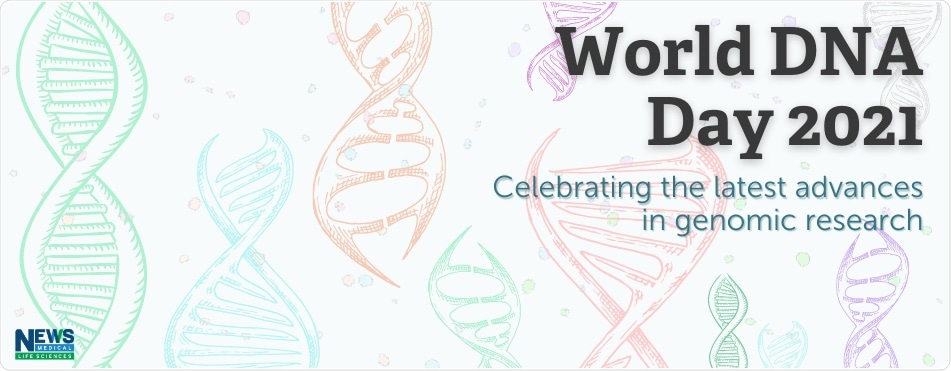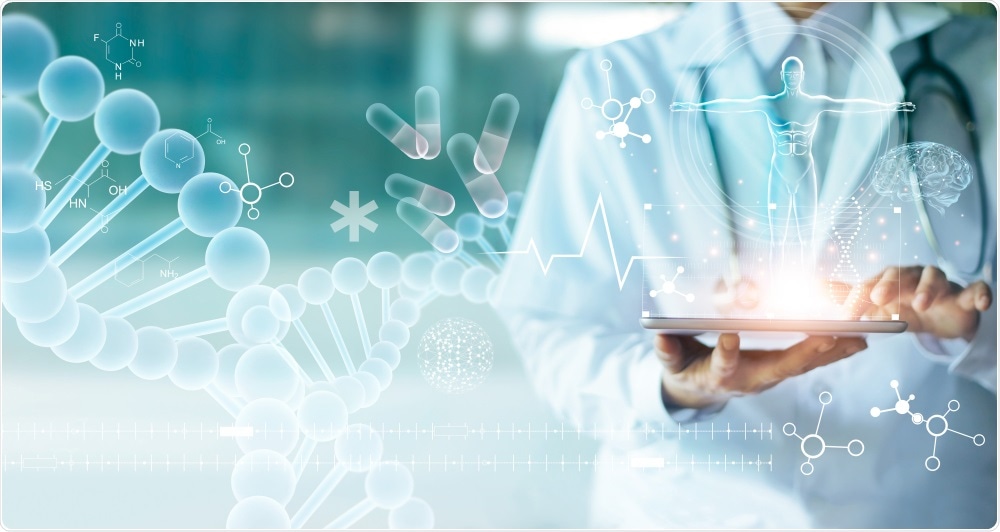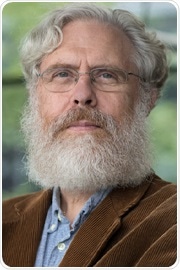In celebration of National DNA Day, AZoLifeSciences interviews renowned DNA expert Professor George Church about his life-long career in DNA research and the human genome.
Please could you introduce yourself and tell us about your role within genomic research?
My name is Professor George Church and I am a Professor at Harvard & MIT, working on reading, writing, and editing DNA (and hence other polymers, inorganic and hybrid materials, cells, organs, organisms, ecosystems).

You currently lead Synthetic Biology at the Wyss Institute. Can you describe the aims of the Wyss Institute and tell us about some of the latest research you are carrying out?
The research we carry out at the Wyss Institute includes Gene therapy delivery (AAV, DynoTx, 64x), Gene editing (Editas), cell therapies (GCTx), Super-resolution multi-omics imaging (Readcoor, 10X genomics, Bruker), and organisms resistant to all viruses via codon recoding.
Current methods for engineering whole genomes are expensive and sometimes inaccurate. Why is important to develop new technologies that can synthesize whole genes faster and more accurately than these current methods?
The key capability is probably making large libraries of genes combined with machine learning. These multiplex analyses lead to new functions via new enzymes, viral capsids, regulatory molecules, and combinations.

DNA in Research. Image Credit: PopTika/Shutterstock.com
How will new technologies like these transform regenerative medicine?
Synthetic nucleic acids, cells, and organs can go far beyond replacing broken parts, handling rare diseases, and the lack of organ donors, but also offer opportunities for enhancements -- for example, resistance to pathogens, senescence, and cancer.
Why does DNA have such a critical role within genomic and human disease research?
DNA is easy to make, copy, and translate into proteins, which in turn provide catalysts, materials, sensors, actuators, etc. Even if DNA is not translated it can have a huge impact, e.g. forensics, ancestry, and storing data compactly.
Please tell us about your research into technology for improving RNA oligonucleotide synthesis and why it is a “greener” approach. How could this technology aid further development in RNA therapeutics?
Chemicals needed for RNA and DNA vaccines, therapies, and information storage are moving to the kilogram-to-ton scale. Our approach to RNA synthesis is harnessing enzymes from nature like polymerases and ligases to replace the current standard syntheses using toxic chemicals like acetonitrile and phosphoramidites, which also are very hard to keep adequately free of water. This might lead to new home biology (analogous to current baking, beer-making, aquaria, gardening, etc.)
Another of the projects you are leading aims to render DNA a viable platform for data storage. What are the benefits of using DNA for the storage of digital information, how could it revolutionize the modern world, and what are the current limitations that need to be overcome?
DNA is about a million times more compact, lasts for a least a million years if kept dry and cool (quite a bit longer than the oldest disk drives); it is easy to copy (we made 70 billion copies of my book "Regenesis" for a few bucks) and it interfaces well with bio/medicine – e.g. we encoded 4 trillion bits about the journey of each cell (developmental lineage from egg to adult) into 30 ng of DNA in each mouse in a colony of engineered mice.
Our next challenges include methods to more efficiently "read" those trillions of bits of information either into computers or back into physiological systems for therapies.
Genetics has had an important part to play over the last year, with the first mRNA vaccine rolled out for use against the COVID-19 pandemic. Do you see genetics further changing the science of vaccines in the next few years, given that research into DNA vaccines is well underway?
Yes. Vaccination is plausibly the only technology equitably distributed to all people, even the very poorest -- especially when we make devastating pathogens like smallpox and rinderpest extinct.
I hope to see vaccine-like therapies against other common diseases like cancer and aging.
Concept of DNA vaccines. Image Credit: Cryptographer/Shutterstock.com
How has COVID-19 impacted your research and how has the Wyss institute responded to the pandemic?
My team worked on 4 major directions: multiplex sequencing diagnostics applicable both to SARS-CoV-2 and more general bio-weather-map applications later, neutralizing peptides and proteins, vaccines focused on mucosal immunity, and needleless and masks.
The pandemic has also impacted me by encouraging the use of video-conferencing rather than travel, which offers a delightfully greener Carbon footprint, fewer scheduling conflicts and it is more efficient.
The COVID-19 pandemic has also shown how collaboration and alignment of goals in the scientific community can enable the development of solutions incredibly quickly. How do you think this could be applied to future research in genetics and what could be achieved?
A similar sharing attitude accompanied the genome project (e.g. sharing raw data weekly), but fizzled out. Possibly more significant is the speed of FDA EUA approval, which maybe be more of a function of the general safety of vaccines than due to new collaboration methods.
Climate change is one of the biggest scientific challenges of the modern world. Genetics may have a part in the fighting and alleviating of its effects, for example in the preservation of biodiversity. How important do you think this area of science is for protecting our future?
Extremely important. However, most solutions focus on slowing the rate of degradation rather than reversing it. If we completely eliminated all anthropogenic sources that would reduce 10 Gtons per year to zero, but we need to go ~100 below zero and we also need to prevent 1400 Gtons at risk of release in the arctic (much of it as methane which is 30-fold worse).
We might be able to get nature to help and turn an inconvenient truth into a very productively green opportunity.
One of the things you are famous for is combining woolly mammoth genes with Asian elephant DNA. What stage is this research in now and could this concept be used to preserve biodiversity?
ReviveRestore.org has brought diversity from ancient animals via frozen cell nuclei —black-footed ferrets and Przewalski's horse (dead 32 & 40 years ago). We are making analogous progress on 4,000 to 40,000-year-old DNA from mammoths, cleaning up older more damaged nuclei by reading and writing DNA (via a computer).
We have made over 22,000 DNA edits in a single human cell and 42 edits in one cell have made their way into a herd of mammals (aka pig version 3.0).
You have had an incredible career, having helped initiate the Human Genome Project and the Personal Genome Project as well as developing the first direct genomic sequencing method. What has been the proudest moment of your career so far?
One 'long-moment' has been watching my students and postdocs succeed and help one another for decades after leaving our lab. The one invention that I think of as the best 'gift that keeps on giving' is 'Molecular multiplexing', which is confused with, but far more powerful than, automation and parallelization.
Molecular multiplexing is the use of natural or synthetic barcodes to enable large libraries (thousands to trillions) of molecules or cells to be mixed, subjected to many steps in the same small volume and roughly the same cost as a single sample.
George Church | The Future of Genome Editing
What do you believe the future of genetics to look like?
Emphasis on preventative medicine, e.g. bio-weather-maps to monitor emerging zoonotic and drug or vaccine-resistant pathogens, or enabling pre-conception matching to reduce severe genetic disorders, (more affordable and safer than IVF or orphan drugs.)
Bio-manufacturing of just about anything in small apartments (clothes, vaccines, foods, electronics) not via conventional 3D printers with one print-head per cubic meter, but via synthetic biology printers with billions of print heads per cubic mm.
Genetics and biotechnology will be an increasingly key component of self-sufficient colonies on earth and space and possibly the fastest space probes ever.
Where can readers find more information?
To read more about Professor George Church and the work carried out at his research lab, click here.
About Professor George Church
George M. Church, Ph.D. ’84 is a professor of genetics at Harvard Medical School, a founding member of the Wyss Institute, and director of PersonalGenomes.org, the world’s only open-access information on human genomic, environmental, and trait data.
Church is known for pioneering the fields of personal genomics and synthetic biology. He developed the first methods for the first genome sequence & dramatic cost reductions since then (down from $3 billion to $600), contributing to nearly all “next-generation sequencing” methods and companies. His team invented CRISPR for human stem cell genome editing and other synthetic biology technologies and applications – including new ways to create organs for transplantation, gene therapies for aging reversal, and gene drives to eliminate Lyme Disease and Malaria.
Church is director of IARPA & NIH BRAIN Projects and National Institutes of Health Center for Excellence in Genomic Science. He has co-authored more than 515 papers and 130 patent publications, and one book, “Regenesis”. His honors include Franklin Bower Laureate for Achievement in Science, the Time 100, and election to the National Academies of Sciences and Engineering.